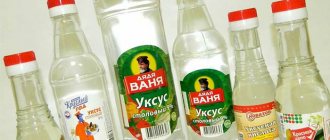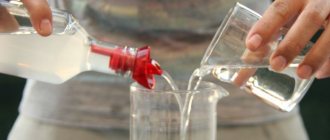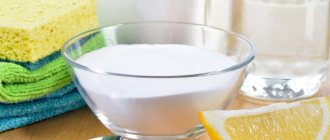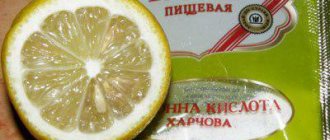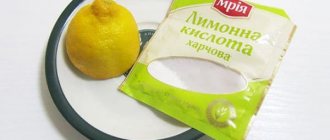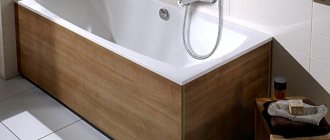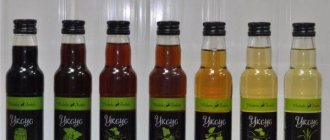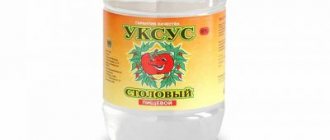Vinegar itself contains calcium, potassium, iron, zinc, phosphorus, copper and selenium. But it is allowed to be used only as one of the ingredients of the dish. You can easily obtain 9% table vinegar from 70% acetic acid using a special table and detailed information in this article.
How to quickly dilute acetic acid 70 to 9: table
Many housewives actively use vinegar for homemade preparations and for other household chores (for example, when you need to clean grease from the microwave). And of course, at this moment they may have a question: how to dilute the vinegar essence to vinegar of the required strength?
As we know, vinegar can be natural and synthetic. Natural vinegar is more expensive, but you can make it yourself at home from fruit (for example, apples or grapes). Natural vinegar contains alcohol. Some housewives sometimes end up with vinegar instead of wine when the fermentation technology is broken.
Synthetic vinegar is made from acetic acid - chemically. This is a cheap option for home cooking, pickling food, and canning. Vinegar is also added to salads, manti sauces, and many other dishes.
So, let's make a table of the main measures that are used on the farm. We will use not only the usual concepts of liter and milliliter, but also tablespoon and teaspoon.
Measuring table: how much water is in a teaspoon and a tablespoon
| spoon | ml | drops |
| tea room | 5 | 100 |
| dining room | 15 | 300 |
From a mathematical point of view, it is quite clear how to dilute 70% acetic acid to a concentration of 9% vinegar. We must reduce the volume by 70/9 = 7.77 times. The number is beautiful, but inconvenient for practical calculations. Therefore, it’s better to measure with spoons - then everything will fall into place.
Making 9 percent vinegar from 70 percent acetic acid is very simple: you need to take 1 part 70% vinegar and 7 parts water. Mix vinegar with water and a solution of 9% vinegar is ready.
So, take 1 incomplete tablespoon of 70% essence and dilute it with 7 tablespoons of water - this is the basic formula, thanks to which we get a 9% solution. In this case, the essence is always taken with an incomplete spoon - then the calculation will be very accurate.
Table: how to dilute acetic acid 70% to 9% vinegar (proportions)
| Acid 70%, half tablespoon | Water, tablespoon | Ready solution 9% |
| 1 | 7 | 100 |
| 2 | 12 | 200 |
| 3 | 18 | 300 |
| 4 | 24 | 400 |
| 5 | 30 | 500 |
| 6 | 36 | 600 |
| 7 | 42 | 700 |
| 8 | 48 | 800 |
| 9 | 54 | 900 |
| 10 | 60 | 1000 (1 liter) |
Of course, everything is done by eye. Therefore, by an incomplete tablespoon we mean an almost filled container, but not to the brim.
And for more accurate measurements, you can take a measuring cup. Although to be fair, such perfect precision is usually not required in the kitchen - after all, fortunately, this is not a laboratory.
Now let's make one more simplification and count water in milliliters. You can also measure it in glasses, assuming that 1 standard glass is 200 ml.
| Acid 70%, half tablespoon | Water, ml | Solution 9%, ml |
| 1 | 90 | 100 |
| 2 | 180 | 200 |
| 3 | 270 | 300 |
| 4 | 360 | 400 |
| 5 | 450 | 500 |
| 6 | 540 | 600 |
| 7 | 630 | 700 |
| 8 | 720 | 800 |
| 9 | 810 | 900 |
| 10 | 900 | 1000 |
What other concentrations of vinegar are there?
In practice, not only the question may arise of how to dilute vinegar essence to 9 percent vinegar. How much water is needed to dilute acetic acid, how to obtain vinegar with a concentration of 3 percent or 5 percent? The following table will help us in this matter (in all cases, the calculation is given for 1 incomplete tablespoon of essence).
Table: how to dilute 70% acid to obtain a vinegar solution
| Vinegar solution, % | Water, tablespoons |
| 3% | 22,5 |
| 4% | 17 |
| 5% | 13 |
| 6% | 11 |
| 7% | 9 |
| 8% | 8 |
| 9% | 6 |
| 10% | 5 |
| 30% | 1,5 |
Generally speaking, acetic acid, vinegar essence, vinegar are the same solution, which consists of 2 components: acetic acid and water. During manufacture, it is always diluted, resulting in different concentrations:
- 70% is vinegar essence;
- 9% table vinegar, which is widely used for marinades, preparations for the winter - cucumbers, tomatoes. tomato juice, etc.
- 6% table vinegar is used to marinate poultry and meat, added to pancakes and homemade cakes;
- 5% vinegar - used in sauces, seasonings, fresh vegetable salads, added to vinaigrette;
- 3% - contains 3 g of acetic acid (it is used for pickling onions, salads, dumplings, etc.)
It is generally accepted that any concentration of a solution up to 15% is vinegar, and everything that is more concentrated is acetic acid. If the concentration is exactly 70%, then it is an essence.
So let’s not confuse these concepts: although chemically these are all the same solution, the concentrations of the main component are different, and the names are also different.
Vinegar at home - 3 recipes
Fruit vinegar is a liquid seasoning that is prepared from fermented cider, juice, fruit wine, beer wort, and naturally sour fruits and berries. The fruit supplement has been known since the times of Ancient Egypt, Rome and Greece. Then Cleopatra made a rejuvenating drink based on fruit vinegar to preserve her beauty and health. In those days, it was used not only in cooking, but also as a cure for ailments. Today, fruit vinegar is, of course, sold on store shelves, but many products are counterfeit, not of high quality and not natural. Therefore, it is better to learn how to prepare this product yourself, exclusively from fruit juice with added honey or sugar. During the manufacturing process, the juice is fermented and alcohol is obtained, and with further mechanical processing, acetic acid is formed.
Practical examples and tables of values
And now from theory to practice. 1-liter, 2-liter and 3-liter jars are usually used when preparing everyone’s favorite homemade preparations for the winter - cucumbers, spicy “Mother-in-law’s Tongue” salad and other table dishes. How much and what should be pledged?
For cucumbers and tomatoes, the ratio of components and water is approximately 1:1. This means that in a liter jar there will be about 0.5 liters of pickling and the same amount of the finished product.
Then we can easily calculate not only how to dilute acetic acid 70 to 9, but also in what quantities to take other products - such tables will help us with this.
| per jar 2 liters | per jar 3 liters | |
| cucumbers | 1 kg | 1.5 kg |
| water | 1 l | 1.5 l |
| salt | 3.5 tbsp (70 g) | 5 tablespoons (100 g) |
| sugar | 1.5 tbsp (30 g) | 2 tbsp (40 g) |
| garlic | 4 cloves | 6 cloves |
| horseradish | 2 sheets | 3 sheets |
| vinegar 9% | 6 tablespoons | 9 tablespoons |
| vinegar 70% | 2 teaspoons | 3 teaspoons |
| dry mustard | 2 dessert spoons | 3 dessert spoons |
These are the simple ratios - print these tables and save them as a reminder. Then the pickles will turn out exceptionally tasty and will be stored well.
Pollock fish cutlets without bread - Not only tasty, but also healthy!
Continuing the theme of healthier eating, I want to offer you a wonderful recipe for fish cutlets - minced pollock cutlets. Pollock is an excellent choice for fish cutlets: it is not an expensive type of fish, has few bones, no need to peel scales, and as for the beneficial properties (content of vitamins A, B1, B2, B9, minerals and trace elements) - it is in no way inferior expensive fish.
The only complaint about pollock is that the minced meat can turn out a little dry. For those who do not have enough fat content, you can roll an additional piece of lard into the minced meat or add a couple of tablespoons of olive oil to the minced meat. For fish cutlets, it is generally typical to take low-fat varieties of white fish, but at the same time increase the fat content with separate additives.
By the way, another original and “tasty” way to add fat content to dry fish (and not only fish) mince. Directly in the frying pan, put a piece of frozen butter into the already prepared cutlets, press it in so that it is inside the minced meat. During cooking, the butter will melt and give the dish a great creamy taste!
But, if we talk about the benefits of such a product as fish cutlets (and this is a dietary dish by all standards!), then you don’t need to add anything, no additional fats are required. This recipe also calls for a small amount of oil in the pan and the absence of bread and flour in the cutlets.
If you don’t have special cookware with a non-stick coating on which you can fry almost without oil, you can cook these cutlets in the oven, or steam them, whichever you prefer.
I still like the cutlets to look more browned; a small, slightly toasted crust won’t hurt, the main thing is to cook over very moderate heat and with a small amount of oil.
Compound:
- minced pollock - 1.3 kg.
- onions – 3 pcs.
medium size
- potatoes – 3 pcs.
- garlic – 3 cloves
- egg – 3 pcs.
- salt, pepper, spices - to taste
Step-by-step recipe for making pollock cutlets:
5 Fry in a small amount of oil, without a lid, over low heat until golden brown, turning during cooking. Fish cutlets cook very quickly. But you can further steam them after frying under the lid, adding a little water.
Let me remind you that in this recipe, for the sake of health benefits and increasing the “dietary value” of our dish, we excluded bread completely. But according to tradition, in the classic recipe for fish cutlets, bread must be added, and in fish cutlets, the bread is usually soaked in milk, and not in water. Still, fish cutlets require more gentle handling
Precautions and safety precautions
And finally, let us remind you about the necessary precautions when diluting vinegar. It is better to carry out this operation with gloves and take care of eye protection.
Avoid contact of the concentrate with the skin, especially the mucous membranes of the eyes and mouth. But if such a nuisance does occur, rinse the affected area under cool running water.
Store vinegar essence and vinegar in a dark place out of reach of children. Remember, this is an acid and can be harmful to your health if not handled correctly.
Can the solution be stored?
Acetic acid is a known preservative. Thanks to it, the preparations stay in jars all winter and do not spoil. So why not store essence water? If 9% vinegar is used frequently, you can dilute 70% acid for future use.
Follow the storage rules:
- Use a glass container or, in extreme cases, a plastic one. Metal containers are not suitable for storing acidic solutions.
- Close the bottle tightly with the cap. The issue of tightness is very important. If the lid allows air to pass through, the liquid will gradually evaporate.
- Store the solution in the refrigerator, pantry, or kitchen counter. The main thing is that the temperature does not go beyond -3 to +35 °C.
- If a kitchen cabinet is used, it is important that it is located away from the stove.
- The vinegar solution must be protected from direct sunlight. Simply storing it on the table is wrong.
- The shelf life of the solution is approximately 24 months. You need to count from the date of manufacture indicated on the bottle.
If you often make a 9% vinegar solution from acid, mark the required level of water and vinegar on the container with a marker. Now, to dilute, you don’t have to weigh anything - you can navigate by the marks.

